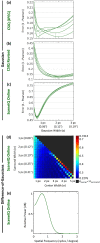Visual stream connectivity predicts assessments of image quality
- PMID: 36219145
- PMCID: PMC9580224
- DOI: 10.1167/jov.22.11.4
Visual stream connectivity predicts assessments of image quality
Abstract
Despite extensive study of early vision, new and unexpected mechanisms continue to be identified. We introduce a novel formal treatment of the psychophysics of image similarity, derived directly from straightforward connectivity patterns in early visual pathways. The resulting differential geometry formulation is shown to provide accurate and explanatory accounts of human perceptual similarity judgments. The direct formal predictions are then shown to be further improved via simple regression on human behavioral reports, which in turn are used to construct more elaborate hypothesized neural connectivity patterns. It is shown that the predictive approaches introduced here outperform a standard successful published measure of perceived image fidelity; moreover, the approach provides clear explanatory principles of these similarity findings.
Figures







References
-
- Ashby, F. G., & Perrin, N. A. (1988). Toward a unified theory of similarity and recognition. Psychological Review, 95, 124.
-
- Berardino, A., Laparra, V., Ballé, J., & Simoncelli, E. (2017). Eigen-distortions of hierarchical representations. Advances in Neural Information Processing Systems, 2017-December, 3531–3540.
-
- Bowen, E. F., Felch, A., Granger, R., & Rodriguez, A. (2018) Computer-implemented perceptual apparatus . U.S. Patent No. PCT/US18/43963.
-
- Bradley, A. P. (1999). A wavelet visible difference predictor. IEEE Transactions on Image Processing, 8, 717–730. - PubMed
-
- Buhrmester, M., Kwang, T., & Gosling, S. D. (2011). Amazon's Mechanical Turk a new source of inexpensive, yet high-quality, data? Perspectives on Psychological Science, 6, 3–5. - PubMed

